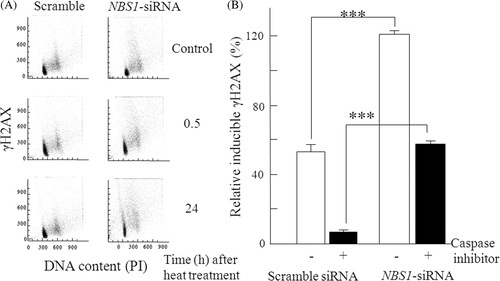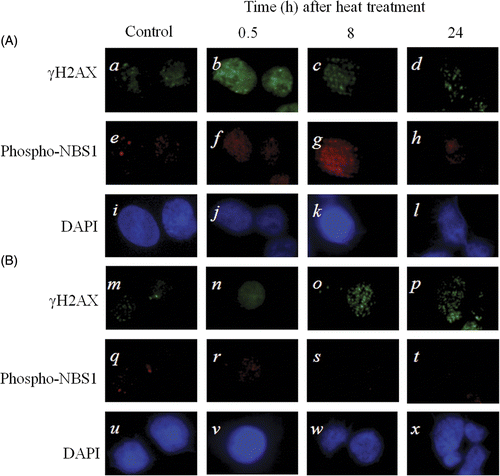Figures & data
Figure 1. NBS1-siRNA transfection in 8305c cells. (A) Transfection efficiency of NBS1-siRNA: (a) phase microscope image; (b) DAPI staining with Cy3-labelled SEC1. (B) Effect of NBS1-siRNA transfection on the accumulation of NBS1 in 8305c cells. Constitutive expression of NBS1 and actin was analysed at 48 h after transfection of scrambled siRNA (lane 1) and NBS1-siRNA (lane 2). (C) The density of the accumulation of NBS1 in 8305c cells in Western blot analysis.
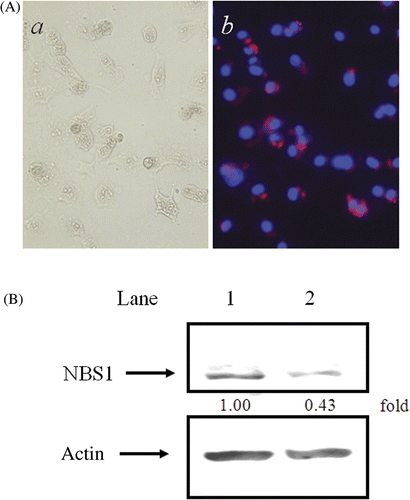
Figure 2. Effect of siRNA silencing of NBS1 on heat-sensitivity at 44°C in 8305c cells. Closed columns, NBS1-siRNA transfected cells; open columns, scrambled siRNA transfected cells. Columns show the means of at least three independent experiments; Vertical bars indicate SDs. *Differences are statistically significant (P < 0.05).
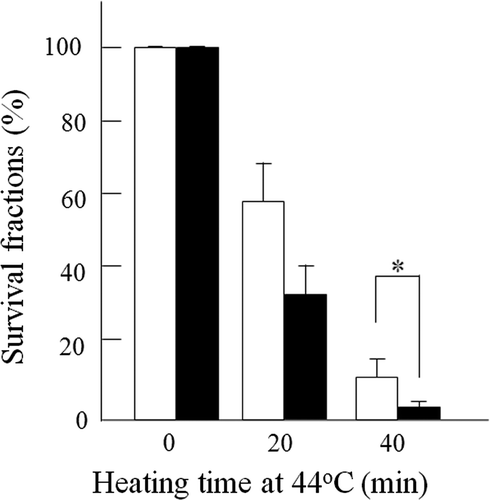
Figure 3. Effect of siRNA silencing of NBS1 on heat-induced apoptosis in 8305c cells. (A) apoptosis was analysed with TUNEL staining 48 h after heat treatment at 44°C for 40 min. Inset photograph: arrows indicate typical TUNEL positive cells. Closed columns, NBS1-siRNA transfected cells; open columns, scrambled siRNA transfected cells. (B, C, D) Apoptosis was analysed with Hoechst33342 staining. (B) Typical photographs of the NBS1-siRNA transfected cells: (a) untreated control cells. (b) 48 h after heat treatment at 44°C for 40 min. Arrows indicate typical apoptotic bodies. (C) Time-dependent apoptosis rates up to 48 h after heat treatment at 44°C for 40 min. (D) Dose-dependent apoptosis rates with a pan-caspase inhibitor 24 h after heat treatment at 44°C for 40 min. •NBS1-siRNA transfected cells; ○Scrambled siRNA transfected cells: each point represents the mean of at least three independent experiments: Vertical bars indicate SDs. ***Statistically significant differences (P < 0.001).
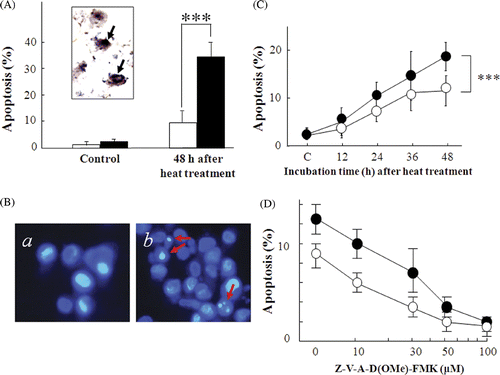
Figure 4. Effect of siRNA silencing of NBS1 on repair of heat-induced DSBs in 8305c cells. (A) The bivariate DNA content vs γH2AX distributions by flow cytometry histograms. (B) The relative inducible γH2AX levels at different time points were normalised against the γH2AX levels measured at 0.5 h and 24 h after treatment with flow cytometry analysis. The γH2AX levels at 0.5 h were set to 100%, and relative γH2AX levels at 24 h were calculated and shown as percentages in the graph. Closed columns, NBS1-siRNA or scrambled siRNA transfected cells with a pan-caspase inhibitor; open columns, NBS1-siRNA or scrambled siRNA transfected cells without a pan-caspase inhibitor. The columns show the means of at least three independent experiments: Vertical bars indicate the SDs; ***Statistically significant differences (P < 0.001).
